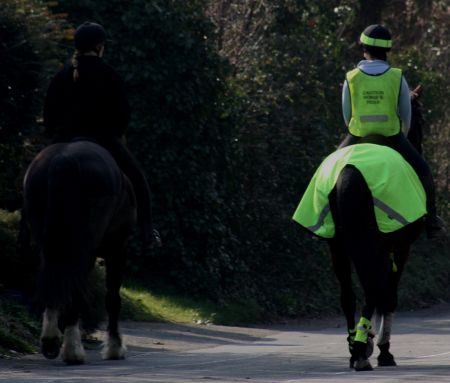Road Safety
If you and your horse are victims of bad driving, then the incident should be reported to the police as soon as possible. It is important to get as much information as possible, including the * Make, registration and colour of vehicle It is not always possible to obtain all of these details. If you get a part registration and the make and colour of the vehicle it may still be possible to locate the driver. If you have no witnesses it is very difficult to secure a conviction as it will be your word against another and the incident will very likely not go to court. When reporting the incident make sure that you make a statement to the police officer even if it is unlikely to go to court, at least it is on record. Make sure that you obtain the officer's collar number and name as well as the station he/she is working from.
In order to help the BHS if you have any horse/rider related traffic accident or near miss please report it to the BHS by Clicking Here.
"A campaign being launched urging motorists to drive carefully when approaching and passing vulnerable road users, such as horse riders, cyclists, walkers and runners. The Road Safety Unit initiative will run until towards the end of April, after which it will be developed into a long-running campaign by a group comprising representatives from several organisations. This follows a meeting hosted by the RSU, which involved groups such as the British Horse Society, the Isle of Man Dressage Group, Manx Equine Services, the Ellan Vannin Native Pony Association, the Cabbyl Club, the Isle of Man Veteran Athletics Club and Northern Athletics. Andrea Georgeson, Road SafetyTraining Co-ordinator, explained: 'We facilitated the meeting after being contacted by several interested parties, such as horse riders, cyclists and dog walkers. The need for this campaign was highlighted by the fact that, as we were planning the meeting, we were told of an incident in which a vehicle hit a horse being ridden by a young girl. 'Fortunately there were no serious injuries in this incident, but obviously the danger is there, not just for the vulnerable road users themselves, but for motorists. The Road Safety Unit was already planning a campaign highlighting the dangers facing vulnerable road users and the timing is appropriate because horse riders, cyclists, runners and walkers will be using the roads more as the nights get lighter. 'The groups involved with the meeting all praised the vast majority of motorists, be they motorcyclists or drivers of cars or lorries, saying they are courteous and respectful. But it's clear that there are a small number of motorists who need to show more consideration to vulnerable road users.' The group that will develop thecampaign into a long-running initiative is in the process of being formed and its aim will be to develop the road safety message during the coming months, with leaflets and posters produced in a bid to get the important message across. Lisa Nixon, a member of both the Ellan Vannin Native Pony Association and the Veteran Athletics Association, said: 'Our aim is to encourage drivers to be more tolerant and aware of vulnerable road users. The majority of the roads are rural, often without footpaths, and the situation is made more hazardous by left hand bends - particularly those with high walls or banks.' An important aspect of the campaign will be to encourage all vulnerable road users to thank considerate drivers and to wear high-visibility or bright clothing when out on the roads. This will be promoted within local groups and sporting organisations. 'We hope to dispel the myth that horse riders and cyclists ride two abreast just to hold a driver up,' said Mrs Nixon. 'For example, there may be a child on the inside or a young horse. Also, riders and cyclists cannot "hug the kerb" - factors such as grids, camber and visibility need to be taken into consideration. 'In a collision the driver could be injured too - cars bend, while people and horses break. The average fully-grown horse weighs half a ton. Cars which hit horses are often extensively damaged and the rider and the driver are likely to sustain injuries. The horse, if not killed outright, often has to be humanely destroyed.' Part of the campaign's message is to encourage motorists to ease off the accelerator and give other road users a suitable amount of space, which means allowing more room when passing cyclists and horses. This gives the cyclist leeway should they wobble or encounter an uneven road surface, while horses may spook at something on their left - for example, a dog suddenly barking in a garden - and jump sideways without warning. For this reason, horse riders often wear tabards asking drivers to 'Please Pass Wide and Slow'. 'This is an ongoing issue,' said Mrs Nixon 'The more the population increases, the more the problem is exacerbated.' Anyone interested in learning more about the group and the campaign can contact Andrea.Georgeson@gov.im or call her on 686684."
|
||||||||||||||||||







